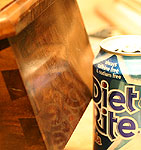This is a Veteran Owned site
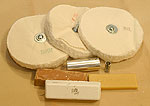 |
The Beall Wood Buff kit makes dramatic finishes simple and fast. Click image to enlarge |
The Beall Wood Buff
Add "Wow" to your projects
Text & Photos by Tom Hintz
New tools are fun to use because they usually work well. The Beall Wood Buff is an exception to that rule, in a very good way. Putting this system to wood for the first time was nothing short of amazing. I suddenly realized how many of those all-over glassy finishes I envied from afar were achieved.
Initial Impressions
The Beall Wood Buff is deceptively simple in appearance. The secret to this system is in the quality of its components and design. The combination makes as easy-to-use system that produces dramatic results.
The Kit
 |
I used the Morse Taper adapter to mount the Buff wheels on my lathe. The threaded rod is long enough to reach through the headstock, locking the adaptor in place. Click image to enlarge |
The Beall Wood Buff consists of three fabric wheels, two bars of polishing compound, a bar of Carnauba wax and a mounting adaptor. This system is designed for use on a slow-speed grinder motor (1725 RPM) with a minimum ½ horsepower rating. Rotation should be counter-clockwise though the instructions address using in on a clockwise rotation motor when necessary.
By adding a Morse taper adaptor, (available from Beall) the kit can be mounted on a lathe, which is how I chose to use it. As mentioned on the Beall web site, I added a piece of ¼-20 threaded rod, a large washer and wing nut that locked the Morse taper adaptor in the lathe as a safety factor.
After mounting the adaptor, the Beall Wood Buff is essentially tool-free in use. The bolt and washers in the center of the fabric wheels fit inside the end of the adaptor, which actually seats against the fabric. The right-hand thread and counter-clockwise rotation keeps the wheel tight during use. However, shut the motor off and the wheel is easily removed by hand for fast changes.
The Wheels
 |
Each wheel is stamped with the material it is to apply. Notice the ring around the bolt where the adaptor actually seats. This makes changing wheels a no-tools deal. Click image to enlarge |
Used first in the three-step process is the all-linen wheel. When loaded with the Tripoli compound this wheel does the bulk of the smoothing/polishing chores. The Tripoli compound is not aggressive enough to replace sanding but has enough tooth to smooth a relatively well-prepared surface to a degree that I did not expect. And, it does its job quickly.
The second wheel used is a combination of linen and cotton, designed for use with the less aggressive White Diamond compound. This step does two things; it removes any remaining Tripoli compound from the surface and does the final polishing. The White Diamond stage seems to even the surface texture, eliminating small dull lines or areas that may remain after the Tripoli step. The White Diamond stage actually polishes the surface so well it appears to be as shinny as it will get, but it's not.
Finally, the all-flannel wheel is used to apply a thin coat of pure Carnauba wax that makes the surface created by the Tripoli and White Diamond stages pop. In addition to the additional shine, the Carnauba wax, commonly recognized as the best for wood, adds a layer of very hard protection to the piece.
In the Shop
 |
If there is a down side to the Beall Wood Buff its in how addictive it can be use. There is little around my house that isn't shinny these days. Click image to enlarge |
The Beall Wood Buff is surprisingly easy to use, and faster than I anticipated. New pieces to be buffed were sanded to 220-grit or 320-grit. Several previously finished pieces were also treated to all three stages of the Beall Wood Buff system. In all cases, the results were impressive to say the least.
A key to using the Beall Wood Buff is to follow the simple instructions and to put enough effort into each stage, something that varies depending on the condition of the wood before the buffing begins. The Beall Wood Buff is capable of shinning up relatively rough wood but the benefits of this system are most pronounced on a sanded surface.
The other important skill in using this system is controlling the amount of pressure applied against the wheel. I quickly learned that the Beall Wood Buff is more effective if just enough pressure is applied to let the wheels and compounds work. Bearing down is not necessary, more effective or faster. It took only a few minutes to get the feel of using the Beall Wood Buff.
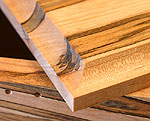 |
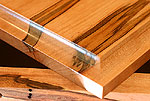 |
The difference between the plain oil finish (left) and after the Beall Wood Buff treatment (right) is as dramatic as it is easy to do. Click images to enlarge |
|
Despite its effectiveness, the Beall Wood Buff is surprisingly gentle on corners. I anticipated burning or rounding edges but that never became a problem. The layers of fabric seem to separate easily enough to prevent damage while polishing the inside corners of routed profiles easily.
Though the Beall Wood Buff works its magic on bare or finished woods, I was most surprised to learn that it is exceptionally useful on wood treated with oil finishes such as Danish or Tung Oil. The depth of the shine produced over oils is remarkable and has quickly become my favorite finish on hardwood projects. Of course, the oil must be completely dry.
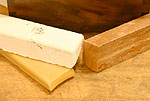 |
I was surprised, and pleased, at the slow rate at which the compound bars are used up. I have buffed everything in sight and the bars hardly show any use at all. Click image to enlarge |
Another surprising fact is the remarkably slow consumption of the compound and wax bars. I have buffed everything I could find, some more than once, but none of the bars is in danger of getting short anytime soon. What I thought might be a hidden cost of using the Beall Wood Buff turned out to be a major incentive.
The only real limitation of the Beall Wood Buffis the size of the pieces that can be buffed. If you can hold and manipulate them against the wheels, the Beall Wood Buff will work its magic.
The Down Side
The only problem created by the Beall Wood Buff was my inability to stop using it. If you are woodturner, you probably understand this kind of addiction. The results of applying the Beall Wood Buff to an existing project can be dramatic and soon had me rummaging through the house looking for things that needed a little shinning up.
Impressions
The Beall Wood Buff is a well-made, well-designed system that performs far better than I anticipated. It is also easy to use, fast and the consumables long-lasting. Despite my incessant buffing, the wheels show no sign of wear or loss of diameter. Combined with the miniscule rate at which the compounds and wax are used and the long-term cost of the Beall Wood Buff system is very low.
With a price of $69.95 (12-2-2005), the Beall Wood Buff is a surprisingly economical way to step up your finishing program. The time and money saved by not having to apply coat after coat of traditional finishes will more than pay for the Beall Wood Buff. Best of all is you get to add professional looking finishes that make your projects look even better.
See our review of the Beall Bowl Buff System - Click Here!
Have a comment on this review? - Email Me!
All written, photographic and drawn materials are property of and copyright by NewWoodworker.com LLC 2000-2019. Materials may not be used in any way without the written permission of the owner.


